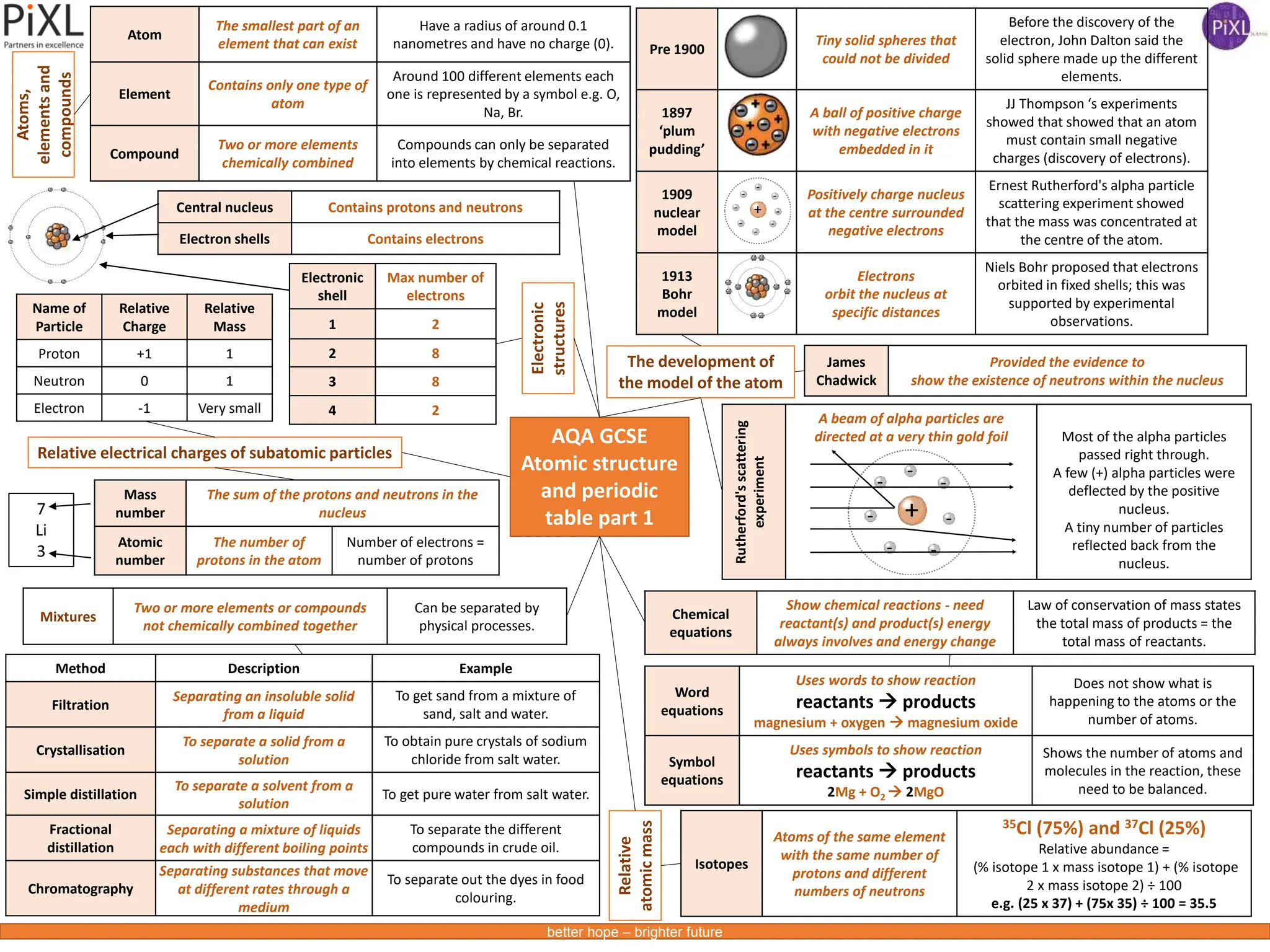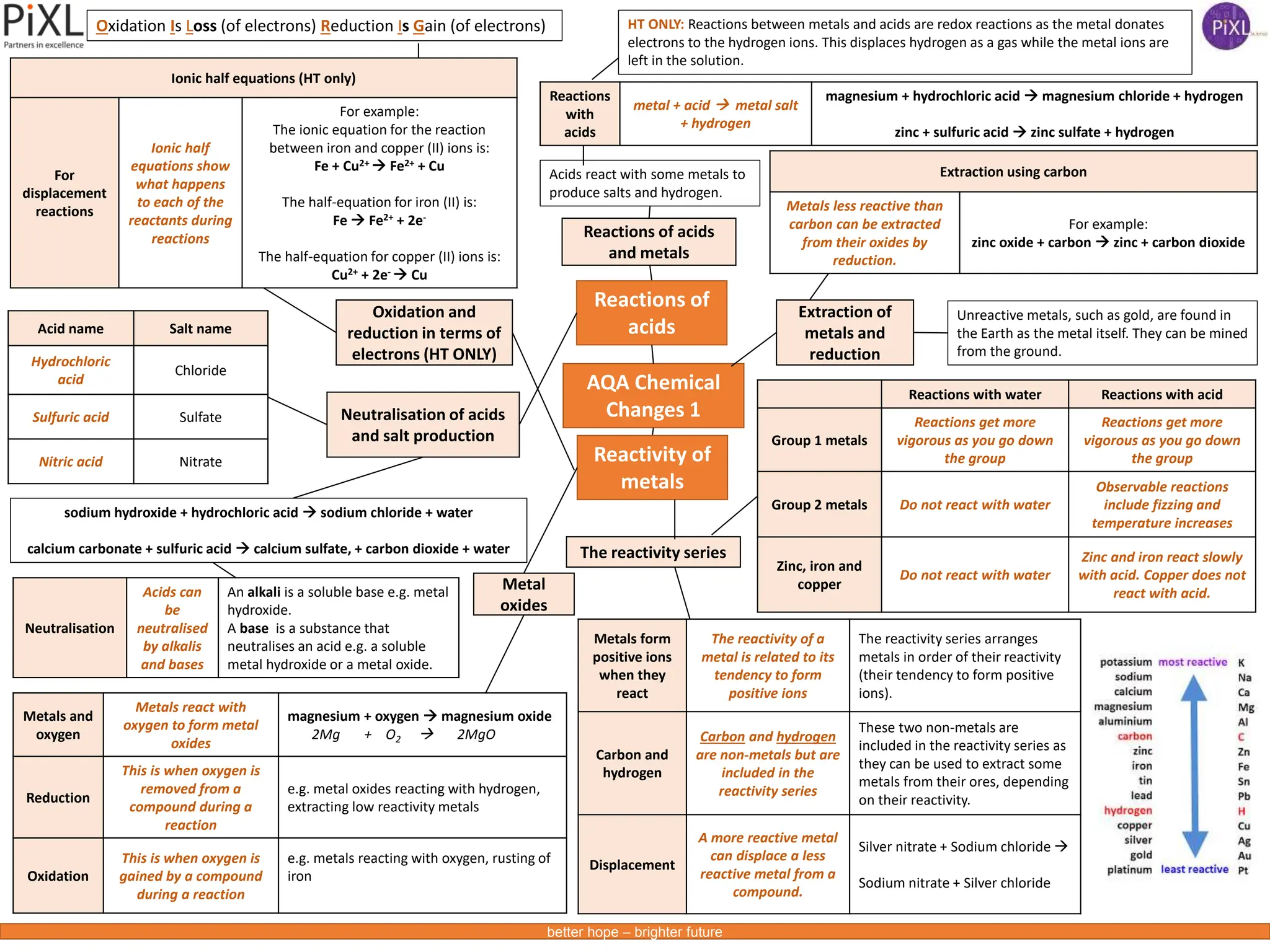Rutherford's scattering experiment showed that the atom has a small, dense nucleus surrounded by electrons. Most alpha particles passed through the gold foil, but some were deflected or reflected, indicating a small, positively charged nucleus. The development of the atomic model over time led to the discovery of subatomic particles like protons, neutrons, and electrons. The periodic table arranges elements in order of atomic number and groups elements with similar properties together.


![better hope – brighter future
AQA
BONDING,
STRUCTURE AND
THE PROPERTIES
OF MATTER 1
The
three
states
of
matter
Ionic
Particles are oppositely
charged ions
Occurs in compounds formed
from metals combined with
non metals.
Covalent
Particles are atoms that
share pairs of electrons
Occurs in most non metallic
elements and in compounds of
non metals.
Metallic
Particles are atoms which
share delocalised
electrons
Occurs in metallic elements
and alloys.
Ionic bonding
Ionic compounds
Metallic
bonding
Properties
of
ionic
compounds
Chemical
bonds
Electrons are transferred so
that all atoms have a noble
gas configuration (full outer
shells).
Metal atoms lose electrons and
become positively charged ions
Group 1 metals form +1 ions
Group 2 metals form +2 ions
Non metals atoms gain electrons to
become negatively charged ions
Group 6 non metals form -2 ions
Group 7 non metals form -1 ions
Dot and
cross
diagram
Giant
structure
Na+ Cl-
Structure
• Held together by strong
electrostatic forces of
attraction between oppositely
charged ions
• Forces act in all directions in
the lattice
High melting and boiling
points
Large amounts of energy needed to
break the bonds.
Do not conduct electricity
when solid
Ions are held in a fixed position in
the lattice and cannot move.
Do conduct electricity
when molten or dissolved
Lattice breaks apart and the ions
are free to move.
Giant structure
of atoms
arranged in a
regular pattern
Electrons in the outer shell
of metal atoms are
delocalised and free to
move through the whole
structure. This sharing of
electrons leads to strong
metallic bonds.
Properties
of
metals
and
alloys
Metals as conductors
Good conductors
of electricity
Delocalised electrons
carry electrical charge
through the metal.
Good conductors
of thermal energy
Energy is transferred by
the delocalised
electrons.
High melting
and boiling
points
This is due to the
strong metallic
bonds.
Pure metals
can be bent
and shaped
Atoms are arranged
in layers that can
slide over each
other.
Alloys
Mixture of two or
more elements at
least one of
which is a metal
Harder than pure metals because
atoms of different sizes disrupt
the layers so they cannot slide
over each other.
s solid
l liquid
g gas
Solid,
liquid,
gas
Melting and
freezing happen at
melting point,
boiling and
condensing happen
at boiling point.
The amount of energy needed
for a state change depends on
the strength of forces between
particles in the substance.
(HT only)
Limitations of simple model:
• There are no forces in the
model
• All particles are shown as
spheres
• Spheres are solid
Pure metal Alloy
Na Na
Cl Cl
x
x
x
x
x
x
x
x
x
x
x
x
x
x
[ [ ]
]
-
+
(2, 8, 1) (2, 8, 7) (2, 8) (2, 8, 8)](https://image.slidesharecdn.com/1515753021aqa-knowledge-mat-gcse-chemistry-p1-231014065754-6e6f9a72/75/1515753021_aqa-knowledge-mat-gcse-chemistry-p1-pptx-3-2048.jpg)




